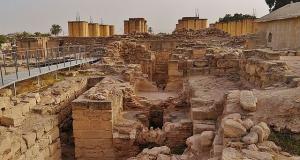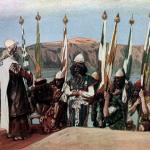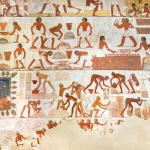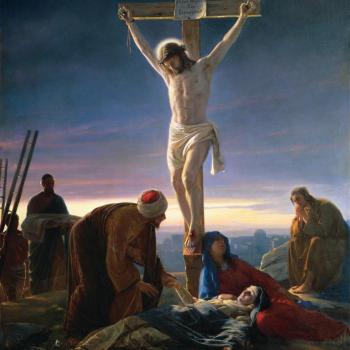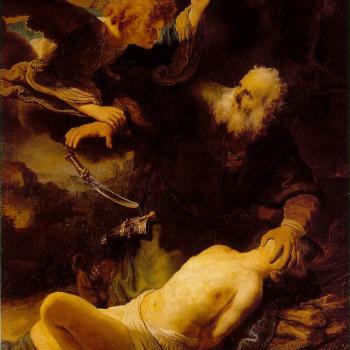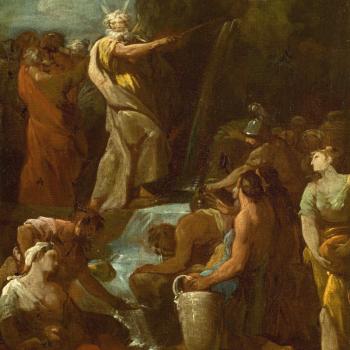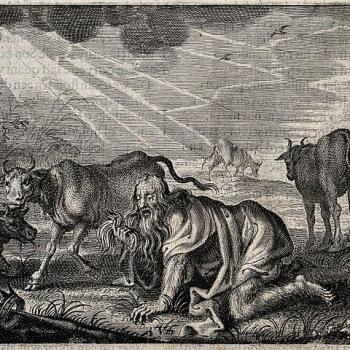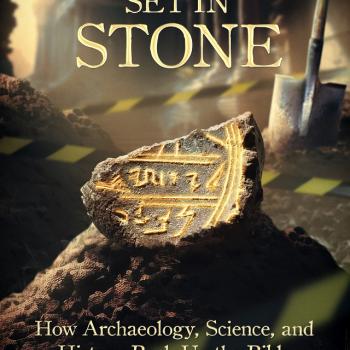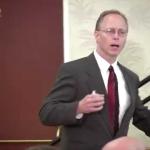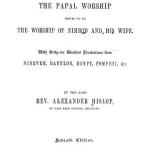Joshua 6:14-15, 20 (RSV) And the second day they marched around the city once, and returned into the camp. So they did for six days. On the seventh day they rose early at the dawn of day, and marched around the city in the same manner seven times: it was only on that day that they marched around the city seven times. . . . So the people shouted, and the trumpets were blown. As soon as the people heard the sound of the trumpet, the people raised a great shout, and the wall fell down flat, . . .
It occurred to me out of the blue that this famous event might possibly have something to do with the known phenomenon of soldiers marching in step across a bridge, causing it to collapse. An article in Live Science provides the basic explanation from physics:
In April 1831, a brigade of soldiers marched in step across England’s Broughton Suspension Bridge. According to accounts of the time, the bridge broke apart beneath the soldiers, throwing dozens of men into the water.
After this happened, the British Army reportedly sent new orders: Soldiers crossing a long bridge must “break stride,” or not march in unison, to stop such a situation from occurring again.
Structures like bridges and buildings, although they appear to be solid and immovable, have a natural frequency of vibration within them. A force that’s applied to an object at the same frequency as the object’s natural frequency will amplify the vibration of the object in an occurrence called mechanical resonance. . . .
If soldiers march in unison across the structure, they apply a force at the frequency of their step.
If their frequency is closely matched to the bridge’s frequency, the soldiers’ rhythmic marching will amplify the vibrational frequency of the bridge. If the mechanical resonance is strong enough, the bridge can vibrate until it collapses from the movement. (1)
Probably the most famous collapse of a bridge was that of the Tacoma Narrows Bridge (suspension design) on November 7, 1940. Many have seen the remarkable video of the large bridge swaying wildly back and forth before collapsing. It wasn’t due to marching soldiers in this instance, but it may very well have been caused by a broadly similar occurrence of destructive resonance. There are several competing scientific explanations for the cause of the disaster, but at least one study opined:
Every system has a natural fundamental vibration frequency. If forces are exerted on that system at the right frequency and phase, then sympathetic vibrations can be excited. Oscillating forces at the right frequency and phase can cause sympathetic vibrations of catastrophic proportions. The forces applied to the bridge by the wind were applied at a natural frequency of the bridge. Thus, the amplitude of the bridge’s oscillations increased until the steel and concrete could no longer stand the stress. (2)
Another article explains the phenomenon in an interesting and more relatable way,
Have you ever felt the windows of your room rattling when a heavy truck lumbers along outside? This happens when the windows vibrate in synch with the natural frequency produced by the truck. This effect is called resonance, but for something really dramatic to take place, a considerably inelastic system has to be subjected to a frequency that perfectly matches its own natural frequency. Therefore, if the truck’s natural frequency was the same as that of the windows, then the mechanical resonance thus created would result in the windows shattering. Similarly, when a singer sings at a frequency high enough to match the natural frequency of a wine glass, she effectively breaks the glass with the power of her voice alone!
When people walk on a bridge, they collectively create complex and scattered frequencies, the combination of which is nowhere near that of the natural frequency of the bridge. However, when soldiers march in unison, the otherwise scattered frequencies of people walking is transformed into a more unified frequency. If this frequency closely matches the bridge’s natural frequency, it could cause the bridge to resonate with amplified vibrations. The stronger the mechanical resonance that is produced, the better the chances are of the bridge collapsing. (3)
What is certain is that this is a known occurrence that has a perfectly natural scientific explanation. I’ve found a few people who actually applied this idea to the collapse of the walls of Jericho, as described in the Bible. Steve Goldman obtained an MS degree in Mechanical Engineering from New York University and has consulted in machinery problem diagnosis and monitoring for over 30 years. He states,
To demonstrate that pulse theory may be applied to a great many varied phenomena, one last case will be covered: the falling of the walls of Jericho. Jericho is one of the oldest known cities on earth. The people of Jericho were not very good wall builders. In fact, the walls of Jericho had fallen many times before the time of Joshua. . . .
Pulse theory yields an interesting insight into this historical event. The blowing ram’s horns and shouting would cause pressure waves of rather high frequency, several hundred to several thousand Hertz. It is extremely unlikely that these pressure waves . . . would have been capable of causing the low natural frequency walls to collapse.
On the other hand, the stomping of a large number of feet on fertile ground would have caused long-time-duration pulses of rather high amplitude. Pulse theory tells us that long-time-duration pulses have most of their energy concentrated in the low-frequency range, near the natural frequency of the wall.
We can surmise, therefore, that the walls of Jericho fell due to the marching of the Jews, . . . (4)
I contended on pages 126-130 in my book, The Word Set in Stone: How Archaeology, Science, and History Back Up the Bible (Catholic Answers Press: March 15, 2023) that there is no archaeological evidence for the walls of Jericho in c. 1200 B.C. (my estimated time for this event, following a certain respectable archaeological timeline), since by then they had totally eroded away, in my opinion, due to a salt-erosion process called haloclasty (Jericho being close to the Dead Sea, which is ten times saltier than the oceans), one of the most arid climates and the lowest elevation in the world, strong winter rains, and non-occupation for some 325 years.
But we know that the second and third levels of walls in Jericho from about 200 years earlier were made of mud, and as such, would not have been particularly strong, and therefore more susceptible to the natural forces being discussed (if later walls were of the same composition). The lower-level wall was made of stone. It’s humorous to note that in my book above I actually stated:
I want to make clear here (so there is no confusion or misunderstanding) that I am not attempting to defend (let alone prove) the claim that the walls fell down because of Joshua and his army marching around it and blowing trumpets. I’m not sure anyone could prove that, and I can’t conceptualize in my mind how they would go about doing so. (p. 127)
I was addressing a different topic there (why walls from 1200 B.C. are absent from Jericho), but it’s funny how I couldn’t even conceive of marching soldiers causing a collapse; and then today, all of a sudden I could conceptualize it, by analogy, and proceeded to give scientific evidence in its favor (i.e., in the possibility of it; not a claimed proof).
Note that in the biblical account the soldiers marched once around the city for six days straight. But on the seventh day “they marched around the city seven times.” On the theories elaborated above, it was not the shouts and trumpet blasts made on the seventh day that caused the collapse of the walls, but the continual marching of soldiers, who were very likely (as with most soldiers in history) in lockstep.
The march around Jericho was possibly not a strange custom to the inhabitants of the city. As Waltke . . . says: “The royal march around the city is based on widespread custom in the ancient Near East of laying claim to territory by tracing out its bounds.” (6) The number of soldiers that Joshua would have commanded, and who would have marched in the procession around Jericho, is estimated by Gabriel (7) . . . to have been about 8,000 men. . . .
But audible sound is not the only result of the marching. Experts include infrasounds (cycles per second in the range below what the human ear can hear) in the science of acoustics. . . . Jones (8) . . ., an expert in viscoelastic vibration damping, also mentions that the vibrations of Joshua’s marching soldiers supposedly are what made the wall fall.
Another possible cause is an earthquake. Jericho sits about four miles away from the Jericho fault. (9) The area has, in fact, been hit by two major earthquakes in the last hundred years: a 6.25 magnitude earthquake in 1927 and another in 2004 (5.1). (10)
That could have been the primary cause (all the more so if inadequate mud brick walls were in play), with the marching and trumpets being merely coincidentally present at the same time. The biblical text, however, neglects to mention it, which would be strange if this is what happened. It doesn’t state that “the ground shook,” or some such, and it’s difficult to imagine that this detail would have been left out, had it actually happened.
For that reason, I favor the “resonance” theory. In either eventuality, it happened right at the time God said it would, which is yet more evidence of his remarkable providential oversight of human events that are in his will. Or it was simply a direct miracle of God, which is always possible at any time (yet rare, too). As in my other book on biblical archaeology, I am merely throwing out natural possibilities or plausible possible events, as opposed to dogmatic assertions that it must have been according to my mere speculations.
FOOTNOTES
1) Elizabeth Howell, “Why Do Soldiers Break Stride On A Bridge?,” LiveScience, May 22, 2013. https://www.livescience.com/34608-break-stride-frequency-of-vibration.html.
2) Robert G. Fuller and Dean A. Zollman, “The Physics of the Tacoma Narrows Bridge Collapse” (citation from p. 11) in Twin Views of the Tacoma Narrows Bridge Collapse (Copyright © 2000, American Association of Physics Teachers). https://www.aapt.org/store/upload/tacoma_narrows2.pdf. See also a fascinating study complete with complicated mathematics: Steven H. Strogatz et al, “Crowd synchrony on the Millennium Bridge,” Nature Vol. 438 (November 3, 2005). https://www.nature.com/articles/438043a.epdf
3) Vaishnavi Patil, “Can A Contingent Of Marching Soldiers Collapse A Bridge?,” ScienceABC, July 8, 2022. https://www.scienceabc.com/humans/can-a-contingent-of-marching-soldiers-collapse-a-bridge.html.
4) Steve Goldman, Vibration Spectrum Analysis (Volume 1) (Industrial Press, Inc., Second Edition, 1999), 220-222. https://reliabilityweb.com/articles/entry/a_look_into_pulse_theory_and_why_the_walls_of_jericho_fell
5) Anne Habermehl, “Archaeoacoustics and the Fall of Jericho,” presented in Archaeoacoustics III: The Archaeology of Sound: Proceedings of the 2017 Conference held in Tomar, Portugal, 2017, pp. 79–84. https://www.researchgate.net/publication/337651856_Archaeoacoustics_and_the_Fall_of_Jericho.
6) Bruce K. Waltke, An Old Testament Theology (Grand Rapids, Michigan: Zondervan, 2007), 519.
7) R. A. Gabriel, The Military History of Ancient Israel (Westport, Connecticut: Praeger Publishers, 2003), 113-114.
8) D. I. G. Jones, Handbook of Viscoelastic Vibration Damping (Chichester, England: John Wiley & Sons, Ltd., 2001), 2.
9) See A. S. Al-Zoubi, T. Heinrichs, I. Qabbani, I., and U. S. ten-Brink, “The northern end of the Dead Sea basin: Geometry from reflection seismic evidence,” Tectonophysics 434 (2007), 55–59.
10) See Amir Sagy et al, “The subsurface structure of the Jericho Fault and the associated deformation: geophysical observations and
mechanical model,” Ministry of National infrastructures: Energy and Water Resources / Geological Survey of Israel (September 2014). https://www.gov.il/blobFolder/generalpage/links-to-earthquake-articles/he/gsi-23-2014.pdf.
***
Practical Matters: Perhaps some of my 4,200+ free online articles (the most comprehensive “one-stop” Catholic apologetics site) or fifty-one books have helped you (by God’s grace) to decide to become Catholic or to return to the Church, or better understand some doctrines and why we believe them.
Or you may believe my work is worthy to support for the purpose of apologetics and evangelism in general. If so, please seriously consider a much-needed financial contribution. I’m always in need of more funds: especially monthly support. “The laborer is worthy of his wages” (1 Tim 5:18, NKJV). 1 December 2021 was my 20th anniversary as a full-time Catholic apologist, and February 2022 marked the 25th anniversary of my blog.
PayPal donations are the easiest: just send to my email address: apologistdave@gmail.com. You’ll see the term “Catholic Used Book Service”, which is my old side-business. To learn about the different methods of contributing, including 100% tax deduction, etc., see my page: About Catholic Apologist Dave Armstrong / Donation Information. Thanks a million from the bottom of my heart!
***
Photo credit: Zairon (3-6-14): Ruins near Hisham’s Palace, Jericho [Wikimedia Commons / Creative Commons Attribution-Share Alike 4.0 International license]
***
Summary: It seems possible that the walls of Jericho may have collapsed due to the resonating frequency produced by soldiers marching around it seven times in lockstep.


